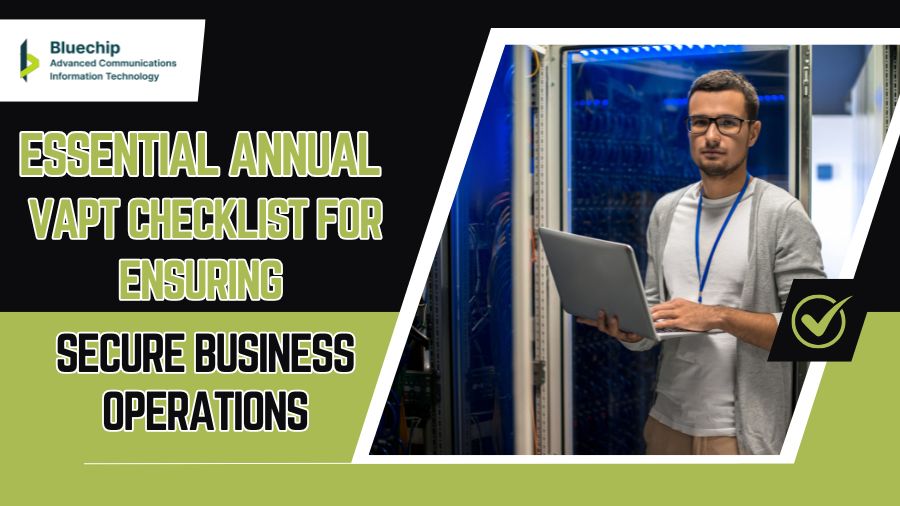
Essential Annual VAPT Checklist for Ensuring Secure Business Operations
Protecting your company from online attacks is more important than ever in the current digital era. One effective strategy to maintain a secure environment is by implementing an annual VAPT checklist. Vulnerability Assessment and Penetration Testing, or VAPT for short, is a thorough process for locating and fixing security flaws before they can be used against you. Whether you’re operating in the Middle East or anywhere around the globe, regular VAPT testing is essential for protecting your business data, reputation, and operational integrity.
In regions like Saudi Arabia, organizations are increasingly turning to specialized services such as VAPT Testing in Saudi Arabia to ensure robust cyber security defenses. Here, we will outline a detailed annual VAPT checklist in easy-to-read language and explain how these practices can lead to secure business operations.
Table of Contents
What Is VAPT Testing?

VAPT testing is a two-pronged method for assessing your company’s security posture –
1. Vulnerability Assessment – This is the process of locating, measuring, and ranking a system’s vulnerabilities is known as vulnerability assessment. It offers a thorough inventory of vulnerabilities that an attacker might use.
2. Penetration Testing – Also referred to as ethical hacking, this stage entails mimicking online attacks in order to take advantage of weaknesses. Evaluating the efficacy of security measures and illustrating the practical consequences of a breach are the objectives.
Together, these assessments provide a clear picture of your organization’s cyber security strengths and areas for improvement.
Why Annual VAPT Testing Is Crucial

The panorama of cyber threats is always changing. Attackers are always improving their methods, and new vulnerabilities appear.
By conducting annual VAPT testing, businesses can –
1. Stay Ahead of Threats – Frequent testing aids in the discovery of new vulnerabilities that could result from infrastructure modifications, new applications, or system updates.
2. Ensure Compliance – Many regulatory frameworks require regular security assessments. An annual VAPT checklist helps ensure compliance with industry standards.
3. Reduce Risk – Early detection and remediation of vulnerabilities decrease the chance of data violations and cyber attacks.
4. Improve Security Posture – Ongoing assessments provide valuable insights into where your security defenses are strong and where improvements are needed.
The Essential Annual VAPT Checklist

Below is a comprehensive checklist to help you plan and execute your annual VAPT testing effectively.
1. Define the Scope and Objectives
Before starting, clearly define the scope of your VAPT testing.
Consider the following –
- Assets to Test – Identify critical systems, networks, and applications.
- Testing Objectives – Determine what you want to achieve—identify vulnerabilities, assess the effectiveness of security controls, or evaluate response mechanisms.
- Compliance Requirements – Add any industry-specific legal or regulatory needs.
A well-defined scope ensures that the testing covers all critical areas without overlooking essential components.
2. Choose the Right Tools and Providers
Selecting the appropriate tools and engaging with experienced professionals is key to successful VAPT testing.
Consider –
- Vulnerability Assessment Tools – Automated scanners that recognize known exposures in your systems.
- Penetration Testing Tools – Advanced software used to simulate attacks and exploit vulnerabilities.
- Professional Services – For instance, organizations in Saudi Arabia can benefit from specialized services such as Penetration testing in Riyadh. These providers have local expertise and understand regional cyber threats.
Choosing the right combination of tools and experts ensures a thorough assessment of your digital infrastructure.
3. Conduct a Comprehensive Vulnerability Assessment
Perform a detailed vulnerability assessment to –
- Scan Systems and Networks – Use automated tools to identify vulnerabilities across servers, endpoints, and network devices.
- Evaluate Software and Applications – Confirm that all applications are up-to-date and free from known vulnerabilities.
- Assess External and Internal Threats – Test both external-facing systems and internal networks to recognize possible entry points for attackers.
This phase lays the groundwork for more targeted penetration testing by providing a list of potential vulnerabilities.
4. Perform Penetration Testing
In order to find out how vulnerabilities might be exploited, penetration testing mimics actual attacks.
This includes –
- External Penetration Testing – Evaluate the security of your public-facing systems, such as websites and online services.
- Internal Penetration Testing – Assess the security of your internal networks, particularly if an attacker gains physical or remote access.
- Social Engineering Tests – Simulate phishing and other social engineering attacks to test employee understanding and reaction.
- Application Security Testing – Identify weaknesses in web and mobile applications that could be exploited by attackers.
By carrying out these tests, you can comprehend the actual danger posed by each exposure.
5. Analyze and Prioritize Findings
After completing the assessments, compile a detailed report that includes –
- Vulnerability Details – A clear description of each identified vulnerability.
- Risk Ratings – Prioritize vulnerabilities based on the possible impact and possibility of exploitation.
- Recommended Remediation – Specific steps to address and mitigate each vulnerability.
- Compliance Impact – Analysis of how these vulnerabilities affect regulatory compliance.
This report will be crucial for your IT security teams to address issues efficiently.
6. Develop an Action Plan
Based on the findings, create a prioritized action plan that outlines –
- Immediate Fixes – Vulnerabilities that require urgent attention.
- Long-Term Improvements – Strategic changes are needed to strengthen overall security.
- Timeline – Set realistic deadlines for remediation efforts.
- Resource Allocation – Ensure that adequate resources are available to implement the solutions.
An effective action plan is the first step toward mitigating identified risks and preventing future incidents.
7. Implement Remediation and Verify
Once the action plan is in place, begin the remediation process –
- Apply Patches and Updates – Ensure all systems and applications are updated.
- Strengthen Security Controls – Enhance firewall rules, access controls, and intrusion detection systems.
- Conduct Training – Educate employees on security best practices, particularly to defend against social engineering attacks.
- Re-Test – After remediation, perform follow-up tests to confirm that exposures have been successfully managed.
Verification is essential to confirm that your security posture has improved.
8. Document and Report
Finally, document every step of the VAPT process –
- Detailed Records – Maintain records of tests performed, vulnerabilities found, and remediation steps.
- Management Reporting – Prepare a summary report for senior management that outlines the improvements in your security posture.
- Compliance Documentation – Keep detailed records to meet any regulatory audit requirements.
Proper documentation not only helps with continuous improvement but also shows a devotion to cybersecurity to stakeholders and regulators.
Conclusion
An annual VAPT checklist is vital for maintaining certain business functions in an increasingly digital world. By following this checklist, organizations can proactively recognize and manage exposures before they lead to expensive cyber incidents. Whether you are utilizing VAPT Testing in Saudi Arabia or opting for Penetration testing in Riyadh, a comprehensive vulnerability assessment and subsequent testing are indispensable components of your cyber defense strategy.
At Bluechip Tech, we understand the importance of cybersecurity. By investing in regular VAPT testing, you not only rescue your business from rising cyber threats but also construct faith with your customers and partners. In a world where cyber attacks are a constant risk, adopting a rigorous and well-documented VAPT process is one of the best ways to ensure that your business remains secure, compliant, and resilient against future challenges.
Read Blog: Cyber Security: Understanding Its Global Significance and Impact









